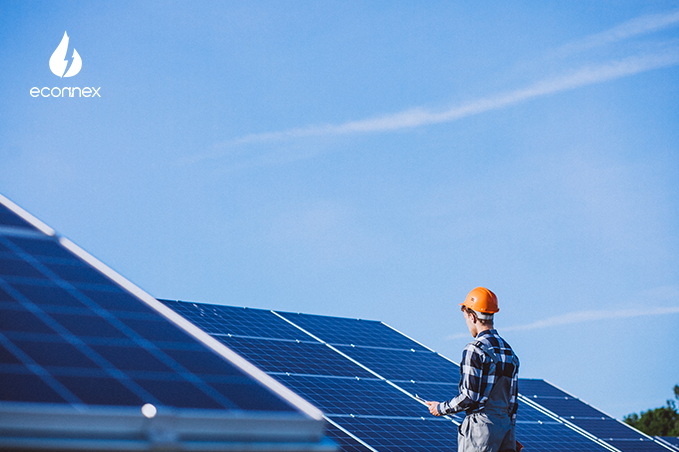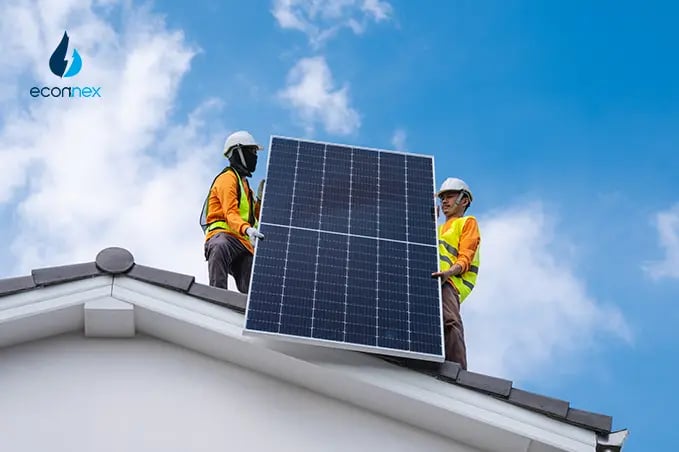Explore the potential of a 6.6-kilowatt solar system & find answers to your questions about solar panel requirements, roof space, costs, payback, and more.

Published on 30/11/2023
By Parneet Kaur
Solar Comparison
As the world shifts towards cleaner and more renewable energy sources, solar power has emerged as a popular choice for homeowners seeking to reduce their carbon footprint and save on electricity bills. This comprehensive guide will delve into the world of 6.6 kilowatt (kW) solar systems, addressing common questions and shedding light on the key factors to consider when investing in this solar technology. Whether you're curious about the number of solar panels needed, required roof space, electricity generation, costs, payback period, or the advantages of oversizing your solar system - Econnex is here to help you make informed decisions and embark on a greener, more sustainable future.
Determining the number of solar panels required for a 6.6kW system depends on various factors, including the wattage of individual panels. Typically, panels with wattages ranging from 300 to 400 watts are used in a 6.6kW setup. As a rough estimate, you may need around 16 to 22 solar panels, depending on their wattage.
The roof space required for a 6.6kW solar power system varies based on the dimensions of the panels, the number required and their arrangement. On average, you will need approximately 40 to 55 square meters of roof space to accommodate a 6.6kW system. However, consulting with solar installation professionals is crucial to determine the precise space requirements for your specific setup.
A 6.6kW solar system has the potential to generate a significant amount of electricity, depending on various factors such as geographical location, panel efficiency, shading, and orientation. On average, a well-designed and properly installed 6.6kW system can produce around 25 to 30 kilowatt-hours (kWh) of electricity daily. This generation capacity can offset a considerable portion of your household's energy consumption.
The cost of a 6.6kW solar power system can vary based on factors such as panel quality, inverter type, installation complexity, and additional components such as a 6kw solar battery cost. A good quality 6.6kW solar system typically costs between $7,500 – $9,500 before any Small-Scale Technology Tokens (STCs) have been deducted. However, many variables affect this pricing, including state or national incentives for solar uptake and extra features such as batteries. A 6.6 KW solar system with a battery included price may be significantly more than battery-less alternatives.
Check - Solar Panel Installation Cost Breakdown
Any available solar rebates can differ for a 6.6kW system, depending on your location. Some markets, like Sydney, are more competitive than others, which can also impact prices. It's essential to obtain multiple quotes from reputable solar providers and consider factors beyond cost, such as product warranties and company reputation, before deciding.
The payback period for a 6.6kW solar system depends on several factors, including your electricity consumption, the amount of sunlight your location receives, the cost of electricity, and the incentives available. Depending on where you live and your electricity consumption habits, paying back a 6.6kW system within five years is possible. You may wonder, “How much will a 6.6 KW solar system save me over its full lifespan?”. Lifetime savings can be upwards of $50,000, and better-quality solar panels that cost more deliver more savings compared to inferior modules, especially in their later years. It's essential to consider the long-term financial benefits and the positive environmental impact when evaluating the payback period.
A 6.6kW solar system has gained popularity among homeowners due to several advantages it offers. Let's explore some of these benefits:
1. Optimal Size for Many Households: A 6.6kW system strikes a balance between affordability, space requirements, and electricity generation capacity. It is suitable for many households with average energy consumption, allowing them to significantly offset their electricity bills and reduce reliance on the grid.
2. Compatibility with Residential Energy Needs: A 6.6kW system can cater to the energy demands of a typical household, powering essential appliances, lighting, electronics, and more. It provides a reliable and sustainable energy source, ensuring a seamless transition to greener living.
3. Maximizing Solar Incentives: By installing a 6.6kW solar system, homeowners can optimise their eligibility for solar incentives, rebates, and feed-in tariffs offered by local governments and electricity providers. These incentives can further accelerate the financial benefits and shorten the payback period.
Oversizing a solar system involves installing a larger capacity of panels with an inverter that is technically undersized, such as matching a 6.6kw array of panels with a 5kw inverter. This approach offers several advantages, including increased energy production during peak sunlight hours, improved performance during low light conditions, and the ability to expand the system in the future. However, oversizing requires careful consideration and consultation with solar professionals to ensure optimal system performance and compatibility.
A 5kW inverter is often paired with a 6.6kW solar panel array to maximise efficiency and power output. The inverter converts DC power from the solar panels into AC power for home use or grid supply and operates best when it's close to its maximum efficiency. A 5kW solar panel array will not consistently produce 5kW of DC power throughout the day due to various factors like time of day, seasonal changes, and panel orientation. However, a 6.6kW array will reach or exceed 5kW more regularly, allowing the 5kW inverter to operate at optimal capacity for more extended periods each day.
Additionally, regulatory requirements play a role in this pairing. Clean Energy Council regulations stipulate that solar panel arrays can't be more than 33% larger than the inverter they're paired with to qualify for the STC rebate. A 6.6kW solar panel array with a 5kW inverter meets this criterion, making it a financially and operationally efficient setup.
If you have more extensive energy demands or the ambition to further reduce your reliance on the grid, you may consider expanding your solar system beyond 6.6kW towards a 10kw array. A 10kW solar power system is ideal for large households with high energy consumption, as it can produce an average of 40kWh of electricity per day. This could be sufficient to power a substantial 5+ bedroom home with all modern amenities, such as central air conditioning, a pool pump, and multiple appliances like refrigerators, washers, and dryers. The system is particularly beneficial for families planning to expand their energy needs, perhaps by adding an electric vehicle (EV) charger or increasing the number of electrical appliances in the home.
Additionally, if your home is connected to the grid, a 10kW system allows you to take advantage of feed-in tariffs, further reducing your electricity bill. The excess power produced during the day can be sent back to the grid, and you can draw from it at night, making the system sustainable and economically advantageous.
Investing in a 6.6-kilowatt solar system presents an opportunity to harness the power of the sun, reduce electricity costs, and contribute to a sustainable future. Through Econnex, consumers gain access to a comprehensive comparison platform that empowers them to make informed decisions when purchasing solar panels. By understanding the number of panels needed, roof space requirements, electricity generation potential, costs, payback period, and the benefits of oversizing, consumers can confidently embark on their solar journey. Explore the advantages of a 6.6kW system, consider oversizing options, evaluate costs, and embrace the potential for further expansion. Econnex is committed to guiding consumers on their path toward solar energy and a greener tomorrow. Start comparing solar panel options with Econnex today and unleash the power of a 6.6-kilowatt solar system in your home!


